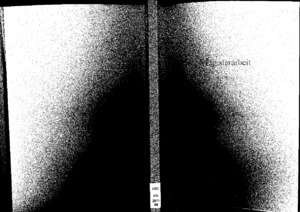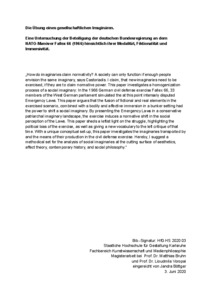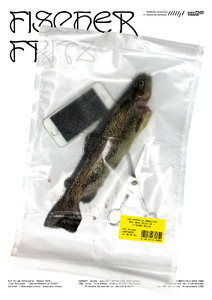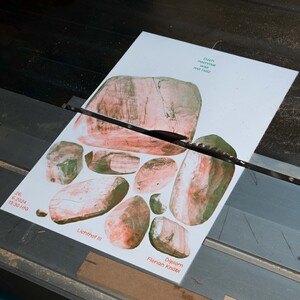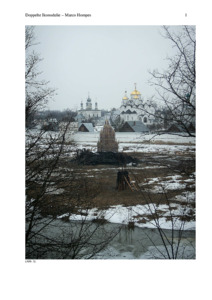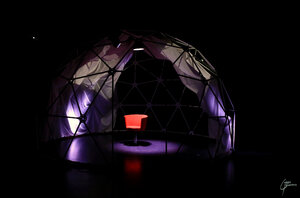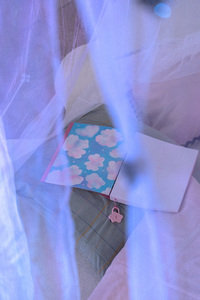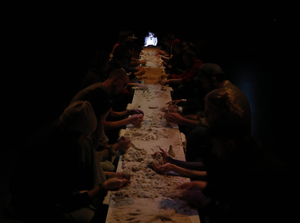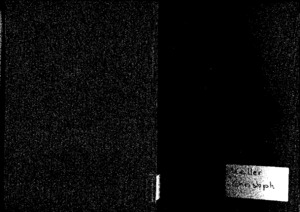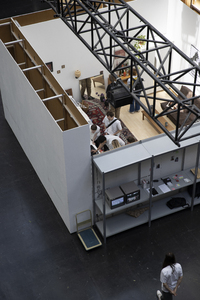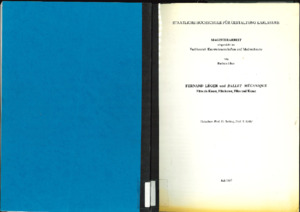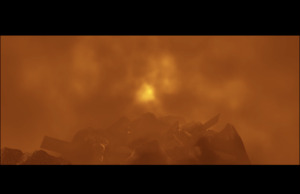"Staatliche Hochschule für Gestaltung (HfG) Karlsruhe"
| Begriff | Staatliche Hochschule für Gestaltung (HfG) Karlsruhe |
| Metakey | Ort: Institution (creative_work:location_institution) |
| Typ | Keyword |
| Vokabular | Werk |
92 Inhalte
Filter werden geladen
- Seite 1 von 8
Die Methode Duchamp – Magritte
- Titel
- Die Methode Duchamp – Magritte
- Untertitel
- Das „Musée d’Art Moderne. Département des Aigles” von Marcel Broodthaers unter dem Aspekt der strategischen Aneignung
- Autor/in
- Beschreibung (de)
- „Der Fall Marcel Broodthaers lädt den Rezipienten dazu ein, sich mit dessen Vorläufern auseinanderzusetzen. Nicht etwa, weil dort Geheimnisse aufzudecken wären – im Gegenteil, die broodthaers’schen Galionsfiguren sind in seinem Werk alle namentlich präsentiert –, sondern eher auf Grund der Tatsache, da er es wie kaum ein anderer verstanden hat, sich bestimmter Vorbilder zu bedienen, sprich, sich Teilaspekte aus deren Werken anzueignen und die darin enthaltenen Kerngedanken eigens fortzuschreiben. Dies geschieht auf eine Art und Weise, die es vermag, Hommage und Kritik zu vereinen.”
„Über zwei Doppelseiten hinweg breitet sich im Ausstellungskatalog zur Section des Figures [...] das graphisch aus, was Broodthaers als seine METHODE tituliert. Diese Blätter folgen in direktem Anschluß an das Vorwort, sie markieren den Anfang zu jenem Katalogteil, der sowohl inhaltlich, als auch formal maßgeblich vom Künstler gestaltet worden ist. Bereits die Typographie des Titelworts strahlt – in Majuskel gesetzt – eine hohe Wichtigkeit aus. Wer allerdings ausführliche Erläuterung erwartet hat, wird enttäuscht, es handelt sich vielmehr um eine anspielungsreiche Illustration als um eine schriftliche Erklärung, doch gleichwohl trägt diese Ausführung den Charakter des Manifests.”
- „Der Fall Marcel Broodthaers lädt den Rezipienten dazu ein, sich mit dessen Vorläufern auseinanderzusetzen. Nicht etwa, weil dort Geheimnisse aufzudecken wären – im Gegenteil, die broodthaers’schen Galionsfiguren sind in seinem Werk alle namentlich präsentiert –, sondern eher auf Grund der Tatsache, da er es wie kaum ein anderer verstanden hat, sich bestimmter Vorbilder zu bedienen, sprich, sich Teilaspekte aus deren Werken anzueignen und die darin enthaltenen Kerngedanken eigens fortzuschreiben. Dies geschieht auf eine Art und Weise, die es vermag, Hommage und Kritik zu vereinen.”
- Beschreibung (en)
- "The case of Marcel Broodthaers invites the recipient to engage with his precursors. Not because there are secrets to be uncovered there - on the contrary, Broodthaers' figureheads are all presented by name in his work - but rather due to the fact that he understood better than almost anyone else how to make use of certain role models, i.e. to appropriate partial aspects from their works and to continue the core ideas contained therein in his own way. This is done in a way that manages to combine homage and criticism."
"Over two double-page spreads in the exhibition catalogue for Section des Figures [...] Broodthaers' METHOD is presented graphically. These pages follow directly after the preface and mark the beginning of the section of the catalogue that was designed by the artist both in terms of content and form. Even the typography of the title word - set in majuscule - radiates great importance. However, anyone expecting a detailed explanation will be disappointed; it is more of an allusive illustration than a written explanation, but this version nevertheless has the character of a manifesto."
- "The case of Marcel Broodthaers invites the recipient to engage with his precursors. Not because there are secrets to be uncovered there - on the contrary, Broodthaers' figureheads are all presented by name in his work - but rather due to the fact that he understood better than almost anyone else how to make use of certain role models, i.e. to appropriate partial aspects from their works and to continue the core ideas contained therein in his own way. This is done in a way that manages to combine homage and criticism."
- Kategorie
- Schlagworte
- Datierung
- November 2010
- Sprache
- Ort: Institution
- Titel
- Die Methode Duchamp – Magritte
- Semester
- Archiv-Signatur
- HfG HS 2010 09
- Externes Archiv
- Importiert am
- 10.01.2025
- Übergeordnete Sets
- 1
- Set enthält
- 0 2
Die Übung eines gesellschaftlichen Imaginären
- Titel
- Die Übung eines gesellschaftlichen Imaginären
- Untertitel
- Eine Untersuchung der Beteiligung der deutschen Bundesregierung an dem NATO-Manöver Fallex 66 (1966) hinsichtlich ihrer Modalität, Fiktionalität und Immersivität.
- Autor/in
- Beschreibung (de)
- „How do imaginaries claim normativity? A society can only function if enough people envision the same imaginary, says Castoriadis. I claim, that new imaginaries need to be exercised, if they are to claim normative power. This paper investigates a homogenization process of a social imaginary: In the 1966 German civil defense exercise Fallex 66, 33 members of the West German parliament simulated the at this point intensely disputed Emergency Laws. This paper argues that the fusion of fictional and real elements in the exercised scenario, combined with a bodily and affective immersion in a bunker setting had the power to shift a social imaginary. By presenting the Emergency Laws in a conservative patriarchal imaginary landscape, the exercise induces a normative shift in the social perception of the Laws. This paper sheds a leftist light on the struggle, highlighting the political bias of the exercise, as well as giving a new vocabulary to the left critique of that time. With a unique conceptual set-up, this paper investigates the imaginaries transported by and the means of their production in the civil defense exercise. Hereby, I suggest a methodical set for the analysis of social imaginaries at the cutting surface of aesthetics, affect theory, contemporary history, and social philosophy.”
- Beschreibung (en)
- „How do imaginaries claim normativity? A society can only function if enough people envision the same imaginary, says Castoriadis. I claim, that new imaginaries need to be exercised, if they are to claim normative power. This paper investigates a homogenization process of a social imaginary: In the 1966 German civil defense exercise Fallex 66, 33 members of the West German parliament simulated the at this point intensely disputed Emergency Laws. This paper argues that the fusion of fictional and real elements in the exercised scenario, combined with a bodily and affective immersion in a bunker setting had the power to shift a social imaginary. By presenting the Emergency Laws in a conservative patriarchal imaginary landscape, the exercise induces a normative shift in the social perception of the Laws. This paper sheds a leftist light on the struggle, highlighting the political bias of the exercise, as well as giving a new vocabulary to the left critique of that time. With a unique conceptual set-up, this paper investigates the imaginaries transported by and the means of their production in the civil defense exercise. Hereby, I suggest a methodical set for the analysis of social imaginaries at the cutting surface of aesthetics, affect theory, contemporary history, and social philosophy.”
- Kategorie
- Schlagworte
- Datierung
- 3. Juni 2020
- Sprache
- Ort: Institution
- Titel
- Die Übung eines gesellschaftlichen Imaginären
- Projektleiter/in
- Semester
- Studiengang
- Typ der Abschlussarbeit
- Archiv-Signatur
- HfG HS 2020 03
- Externes Archiv
- Importiert am
- 30.03.2025
- Übergeordnete Sets
- 1
- Set enthält
- 0 4
DNS #69
- Titel
- DNS #69
- Untertitel
- Fischer Fritz
- Autor/in
- Beschreibung (de)
- Frische Fische kann Fischer Fritz nicht mehr fischen. Nicht erst seit seinem Schlaganfall. Sein Sohn Franz ist kein Fischer geworden, sondern Frisör in der Großstadt. Um den Vater zu versorgen hat er eine ausländische Pflegekraft engagiert. Ein Sprechtheater nennt die Autorin Raphaela Bardutzky ihr Stück, das bei den Autor*innentheatertage 2022 am Deutschen Theater in Berlin ausgezeichnet wurde. Sprachlich virtuos, tragisch-komisch und spielerisch leicht erzählt sie von Heimat und Fremde, Sehnsucht und Einsamkeit, Stadt und Land, Alter und Jugend. Im Anschluss findet ein Gespräch mit der Autorin Raphaela Bardutzky statt.
- Beschreibung (en)
- Fisherman Fritz can no longer catch fresh fish. Not just since his stroke. His son Franz has not become a fisherman, but a hairdresser in the big city. He has hired a foreign carer to look after his father. Author Raphaela Bardutzky calls her play, which won an award at the Autor*innentheatertage 2022 at the Deutsches Theater in Berlin, spoken theater. With virtuoso language, tragic-comic and playful lightness, it tells of home and foreignness, longing and loneliness, city and country, age and youth. This will be followed by a discussion with the author Raphaela Bardutzky.
- Typ des Projekts/Werks
- Schlagworte
- Datierung
- 04.02.2023
- Mitwirkende
- Sprache
- Ort: Institution
- Ort
- Großes Studio
- Stadt
- Land
- Beteiligte Institution(en)
- Titel
- DNS #69
- Projektleiter/in
- Semester
- Studiengang
- Lehrveranstaltung
- Importiert am
- 20.12.2023
- Übergeordnete Sets
- 1
- Set enthält
- 0 10
Doch nochmal was mit Holz
- Titel
- Doch nochmal was mit Holz
- Autor/in
- Beschreibung (de)
- In meinem Diplom „Doch nochmal was mit Holz“ werden ausschließlich Holzreste von abgestorbenen Bäumen und solchen, die industriell keine Verwendung bekommen können transformiert. Äste werden jetzt zu ziegelartigen Holzsteinen, andere Teile des Baumes zu Natursteinen oder Geröll.
Ergänzt wird diese Holzwelt durch übergroße Nägel aus hochgebranntem Ton, die geschmiedete Metallnägel, verrostet und neu, nachahmen.
- In meinem Diplom „Doch nochmal was mit Holz“ werden ausschließlich Holzreste von abgestorbenen Bäumen und solchen, die industriell keine Verwendung bekommen können transformiert. Äste werden jetzt zu ziegelartigen Holzsteinen, andere Teile des Baumes zu Natursteinen oder Geröll.
- Beschreibung (en)
- In my diploma “Doch nochmal was mit Holz”, only wood residues from dead trees and those that cannot be used industrially are transformed. Branches now become brick-like wooden stones, other parts of the tree become natural stones or boulders.
This world of wood is complemented by oversized nails made of high-fired clay that imitate forged metal nails, rusted and new.
- In my diploma “Doch nochmal was mit Holz”, only wood residues from dead trees and those that cannot be used industrially are transformed. Branches now become brick-like wooden stones, other parts of the tree become natural stones or boulders.
- Kategorie
- Schlagworte
- Dank an
- Material
- Ort: Institution
- Ort
- Lichthof 3
- Stadt
- Land
- Beteiligte Institution(en)
- Titel
- Doch nochmal was mit Holz
- Projektleiter/in
- Semester
- Studiengang
- Typ der Abschlussarbeit
- Importiert am
- 06.10.2024
- Übergeordnete Sets
- 1
- Set enthält
- 0 14
Doppelte Ikonodulie
- Titel
- Doppelte Ikonodulie
- Autor/in
- Beschreibung (de)
-
„Diese Arbeit beschäftigt sich mit dem scheinbaren Widerspruch zwischen musealer und religiöser Bildbetrachtung und der Frage, welche Kriterien diesen zu Grunde liegen. Ausgangspunkt für diese Fragestellung stellt eine Debatte dar, die in Russland geführt wird. Dort wurden sämtliche Kirchen nach der Oktoberrevolution 1917 enteignet. Der Besitz ging an den Staat über, was zur Folge hatte, dass viele der ursprünglich sakralen Objekte und Bauten zerstört, umgenutzt oder an Museen übergeben wurden. Nach dem Ende des Kommunismus in Russland wurde die Frage nach der Rückgabe dieser Besitztümer häufig gestellt. Aber erst 2007 kam es zu konkreten Planungen zu einem Gesetz zur „Übergabe des in staatlichem oder städtischem Besitz befindlichen Eigentums religiöser Zweckbestimmung an die religiösen Organisationen“ von Seiten des Staates. Dieses Gesetz sollte den Kirchen des Landes eine rechtliche Grundlage für Restitutionsforderungen bieten. Zeitgleich fühlen sich russische Museen durch das Gesetz in ihrem Bestand und in ihrer Existenz bedroht.”
„Die Frage, wem man in einer solchen Auseinandersetzung Recht geben sollte, ist durchaus schwierig: den Museen, die Kulturgüter (wie Ikonen) schützen, oder den Kirchen, für die Bilder Instrumentarien darstellen, die eine aktive Rolle im kirchlichen Ritus spielen und auch genau für diesen Zweck hergestellt wurden? Es geht also um die Frage, ob man sakrale Objekte, Kultwerke also, als Kunstwerke behandeln darf beziehungsweise wie dies zu rechtfertigen ist. Um diese Frage zu klären, ist es nötig den grundsätzlichen Umgang mit Bildern beider Institutionen zu klären. Hieraus ergeben sich auch Fragestellungen für die westlichen Museen und ihren bisherigen Gültigkeitsanspruch.”
-
- Beschreibung (en)
- ‘This work deals with the apparent contradiction between museum and religious image viewing and the question of which criteria underlie these. The starting point for this question is a debate that is taking place in Russia. There, all churches were expropriated after the October Revolution in 1917. The property was transferred to the state, which meant that many of the originally sacred objects and buildings were destroyed, repurposed or handed over to museums. After the end of communism in Russia, the question of returning these possessions was frequently raised. However, it was not until 2007 that concrete plans were made by the state for a law on the ‘transfer of state-owned or municipally-owned religious property to religious organisations’. This law was intended to provide the country's churches with a legal basis for restitution claims. At the same time, Russian museums feel that their existence is threatened by the law.’
‘The question of who should be given the right in such a dispute is a difficult one: the museums, which protect cultural assets (such as icons), or the churches, for which images are instruments that play an active role in the church rite and were produced precisely for this purpose? The question is therefore whether sacred objects, i.e. works of worship, may be treated as works of art and how this can be justified. In order to clarify this question, it is necessary to clarify the fundamental handling of images in both institutions. This also raises questions for Western museums and their current claim to validity.’
- ‘This work deals with the apparent contradiction between museum and religious image viewing and the question of which criteria underlie these. The starting point for this question is a debate that is taking place in Russia. There, all churches were expropriated after the October Revolution in 1917. The property was transferred to the state, which meant that many of the originally sacred objects and buildings were destroyed, repurposed or handed over to museums. After the end of communism in Russia, the question of returning these possessions was frequently raised. However, it was not until 2007 that concrete plans were made by the state for a law on the ‘transfer of state-owned or municipally-owned religious property to religious organisations’. This law was intended to provide the country's churches with a legal basis for restitution claims. At the same time, Russian museums feel that their existence is threatened by the law.’
- Kategorie
- Schlagworte
- Datierung
- 17.10.2011
- Sprache
- Ort: Institution
- Titel
- Doppelte Ikonodulie
- Projektleiter/in
- Semester
- Studiengang
- Typ der Abschlussarbeit
- Archiv-Signatur
- HfG HS 2011 03
- Externes Archiv
- Importiert am
- 12.01.2025
- Übergeordnete Sets
- 1
- Set enthält
- 0 3
ERLEBNIS THEATER
- Titel
- ERLEBNIS THEATER
- Untertitel
- Für eine wahrnehmungszentrierte Raumtheorie im Theater
- Untertitel des Projekts/Werks (en)
- For a perception-centered theory of space in the theater
- Autor/in
- Beschreibung (de)
- Das Projekt behandelt die sensitive Wahrnehmung in Räumen und kritisiert dessen Nicht-Vorhandensein speziell in Theater-Architekturen.
- Beschreibung (en)
- The project deals with sensitive perception in spaces and criticizes its non-existence, especially in theater architecture.
- Kategorie
- Schlagworte
- Datierung
- Mai 2021
- Mitwirkende
- Ort: Institution
- Ort
- Großes Studio
- Stadt
- Land
- Internetlinks
- Titel
- ERLEBNIS THEATER
- Projektleiter/in
- Semester
- Studiengang
- Typ der Abschlussarbeit
- Importiert am
- 14.06.2024
- Übergeordnete Sets
- 1
- Set enthält
- 0 11
eternal girlhood
- Titel
- eternal girlhood
- Untertitel
- oh my dreams
- Autor/in
- Beschreibung (de)
- “eternal girlhood” ist eine konzeptionelle Arbeit, welche aus einer Rauminstallation und einer Publikation besteht.
Ursprünglich in den Chinesischen Pavillons des Fasanengartens in Karlsruhe installiert, wurde der Raum mit der Handlung der Publikation durch Requisiten sowie ein selbst produziertes Musikstück verknüpft.
Das Projekt ermöglicht eine Reise in eine poetische Geschichte, inspiriert von persönlichen und kulturellen Themen wie Girlhood, Coming-of-Age und Growing Pains.
Die handgebundene Publikation mit glitzerndem und geprägtem Umschlag umfasst auf ca. 100 Seiten neben Serien analoger Schwarzweiß-Fotografie farbige Mittelformat-Fotos, begleitet von analogen Schnappschüssen und Illustrationen im Riso-Druck.
Zwischen Fotoserien und Illustrationen sind Songtexte sowie Skriptfragmente und Gedichte eingestreut, in Referenz zu Filmsequenzen aus Coming-of-Age-Geschichten. Es ergibt sich die zeitlose Skizze eines Mädchens, das Teil einer innig verbundenen Mädchengruppe ist.
Transparente Drucke von drei Mittelformat-Fotografien werden vom Fensterlicht erleuchtet und symbolisieren in Zusammenhang mit dem Buch unterschiedliche Kapitel der Geschichte.
Unter einem Baldachin, umgeben von funkelnd tanzenden Schmetterlingen, können Besucher*innen in diese Welt eintauchen und sind eingeladen, für einen Moment Teil von „eternal girlhood“ zu sein, fernab der Echtzeit.
- “eternal girlhood” ist eine konzeptionelle Arbeit, welche aus einer Rauminstallation und einer Publikation besteht.
- Beschreibung (en)
- “eternal girlhood“ is a conceptional artwork, blending a publication with its installation space.
Initially installed in the Chinese pavillons of the Fasanengarten in Karlsruhe, the space was connected to the story of the book through props and a musical sound score.
The project offers a journey into a poetic story, inspired by personal and cultural ideas on girlhood, coming of age and growing pains.
Handbound, wrapped in a glittery embossed dustcover, the publication features around 100 pages with multiple series of black and white film photography, medium format shots underlined by analog snapshots and Riso printed Illustrations. In between the chapters of photography and Illustrations, lyrics, fragments of script and poems are inserted in reference to movie sequences from coming of age stories. A timeless profile of a girl being part of girlhood and a deeply connected friendship is created.
Transparent prints of three medium format photos are illuminated by the windows’ natural light and symbolize different chapters of the story in combination with the book.
Underneath a canopy, surrounded by sparkling dancing butterflies, visitors can dive into this world and are invited to become part of “eternal girlhood“, away from modern reality.
- “eternal girlhood“ is a conceptional artwork, blending a publication with its installation space.
- Kategorie
- Typ des Projekts/Werks
- Schlagworte
- Datierung
- 05.07.2024
- Mitwirkende
- Dank an
- Sprache
- Material
- Technik/Verfahren/Formate
- Risographie, Digitaldruck, Mediumformat-Fotografie, Schreibmaschine, Laser, Prägung
- Abmessungen
- Fläche: ca. 5m x 5m, Höhe der Aufhängung ca. 3m
- Ort: Institution
- Ort
- Chinesische Pavilions des Fasanengarten
- Stadt
- Land
- Beteiligte Institution(en)
- Titel
- eternal girlhood
- Projektleiter/in
- Studiengang
- Typ der Abschlussarbeit
- Importiert am
- 05.11.2024
- Übergeordnete Sets
- 1
- Set enthält
- 0 21
Etwas Aufnehmen
- Titel
- Etwas Aufnehmen
- Titel (en)
- Get in touch with
- Untertitel
- Eine Reading Performance in 4 Teilen
- Untertitel des Projekts/Werks (en)
- A reading performance in 4 chapters
- Autor/in
- Beschreibung (de)
- "Etwas Aufnehmen" ist eine 30-minütige interaktive Reading Performance über den (Tast-) Sinn. Sie findet an einem 15 m langen Steintisch statt, 80 kg kinetischer Sand liegen auf ihm verteilt. Die Performance entstand in sechsmonatiger Recherche und im Austausch mit einer blinden Künstlerin, einem Tastforscher, einem Übersetzer von visuellen Lernmaterialien und einer Tierkommunikationsexpertin und erzählt außerdem von einer Kollaboration mit einem Hund (Betty). Welchen Stellenwert nimmt der Tastsinn in unserer Wahrnehmung ein, um Dinge wortwörtlich zu "begreifen"? Wie kommuniziere oder gestalte ich mit einem Tier, welches auf ganz andere Sinne zurückgreifen kann? "Etwas Aufnehmen" hinterfragt die eigene Wahrnehmung und beschreibt den Drang nach Verständigung. Die Reading Performance ist sowohl taktil, auditiv als auch visuell wahrnehmbar.
- Beschreibung (en)
- "Get in touch with" is a 30-minute interactive reading performance about the (tactile) sense. It takes place on a 15 metre long stone table with 80 kg of kinetic sand on top. The performance is the result of a six-month research and exchange with a blind artist, a tactile researcher, a translator of visual learning materials and an animal communication expert, and also tells of a collaboration with a dog (Betty). What role does the sense of touch play in our perception? How do I communicate or design with an animal that has access to completely different senses? "Etwas Aufnehmen" questions our own perception and describes the urge for understanding. The reading performance can be experienced tactilely, acoustically and visually.
- Kategorie
- Typ des Projekts/Werks
- Schlagworte
- Datierung
- Februar 2023
- Mitwirkende
- Dank an
- Sprache
- Untertitel (Film)
- Material
- Abmessungen
- Länge: 15m, Breite: 25cm, Höhe: 25cm
- Dauer
- 30min
- Ort: Institution
- Ort
- Großes Studio
- Stadt
- Land
- Internetlinks
- Titel
- Etwas Aufnehmen
- Projektleiter/in
- Semester
- Studiengang
- Typ der Abschlussarbeit
- Importiert am
- 05.10.2024
- Übergeordnete Sets
- 1
- Set enthält
- 0 16
Excreta Fluxorum - Theatrum Instrumentorum
- Titel
- Excreta Fluxorum - Theatrum Instrumentorum
- Untertitel
- George Maciunas und die Kultur der „curiositas”
- Autor/in
- Beschreibung (de)
- „Möglicherweise erscheinen die intermediären Kunstformen der 60er-jahre als zu komplex, ihre Manifestationen zu sehr als Teil einer noch lebenden Kunstgeschichte, vielleicht hindert auch die noch nicht abgeschlossene Bewältigung der postmodernen Wende in Philosophie, Kunst und Literatur an einer generalüberholten wissenschaftlichen Annäherung an diesen Themenbereich, der sich von der fließenden, aus Künstlerkommentaren über Kritiken in methodischen Darstellungen hervorgegangenen bisherigen Versuchen einer vorläufigen Einordnung des Phänomens Fluxus abzugrenzen hätte."
- Beschreibung (en)
- “It is possible that the intermediary art forms of the 1960s appear too complex, their manifestations too much a part of a still living art history; perhaps the fact that the postmodern turn in philosophy, art and literature has not yet been completed also prevents a generally overhauled academic approach to this subject area, which would have to distinguish itself from the fluid attempts at a provisional classification of the phenomenon of Fluxus that have emerged from artists' commentaries on critiques in methodical presentations.”
- Kategorie
- Typ des Projekts/Werks
- Schlagworte
- Datierung
- 04.03.1999
- Sprache
- Ort: Institution
- Stadt
- Land
- Titel
- Excreta Fluxorum - Theatrum Instrumentorum
- Projektleiter/in
- Semester
- Studiengang
- Typ der Abschlussarbeit
- Archiv-Signatur
- HfG HS 1999 01
- Externes Archiv
- Importiert am
- 11.01.2024
- Übergeordnete Sets
- 1
- Set enthält
- 0 3
existence.exe
- Titel
- existence.exe
- Titel (en)
- existence.exe
- Autor/in
- Beschreibung (de)
- Das Konzept der „Selbstoptimierung“ hat eine zunehmende gesellschaftliche Relevanz erreicht, dementsprechend haben zahlreiche Apps, die sich auf den Körper, die Emotionen und das Selbstmanagement konzentrieren, nach und nach mein Leben durchdrungen.
Ich scheine gleichzeitig in zwei Formen zu existieren: einerseits als organisches Wesen, das aus Wahrnehmung, Widersprüchen und zufälligen Erfahrungen besteht; andererseits als digitales Modell, das von verschiedenen Anwendungen konstruiert wurde.
Allmählich gewöhnte ich mich daran, mich selbst über Zahlen zu messen und zu analysieren – von der Kalorienaufnahme über Schlafzyklen bis hin zu feinen Schwankungen der Herzfrequenz – doch dabei verlor ich zunehmend das Vertrauen in die natürliche Wahrnehmung meines Körpers.
Diese Programme geben vor, „personalisierte Dienste“ zu sein, verwandeln uns letztlich aber in ein einheitliches Datenformat, das sich bequem kategorisieren, vergleichen und extrahieren lässt.
Je mehr Daten es über mich gibt, desto weniger scheine ich mich selbst zu spüren.
- Das Konzept der „Selbstoptimierung“ hat eine zunehmende gesellschaftliche Relevanz erreicht, dementsprechend haben zahlreiche Apps, die sich auf den Körper, die Emotionen und das Selbstmanagement konzentrieren, nach und nach mein Leben durchdrungen.
- Beschreibung (en)
- As “self-optimization” has become a widely accepted life concept, a large number of apps focusing on the body, emotions, and self-management have gradually infiltrated my life.
I seem to exist in two forms at the same time: one, an organic being composed of perception, contradictions, and incidental experiences; the other, a digital model constructed by various applications.
I gradually got used to measuring and examining myself through numbers—from calorie intake to sleep cycles and subtle fluctuations in heart rate—but in doing so, I slowly lost trust in my body’s natural perception.
These programs present themselves as “personalized services,” yet ultimately convert us into a single data format, convenient for categorization, comparison, and extraction.
The more data there is about me, the less I seem to feel myself.
- As “self-optimization” has become a widely accepted life concept, a large number of apps focusing on the body, emotions, and self-management have gradually infiltrated my life.
- Kategorie
- Typ des Projekts/Werks
- Schlagworte
- Datierung
- 14.05.2025
- Mitwirkende
- Dank an
- Dauer
- 2 Tage
- Ort: Institution
- Ort
- Lichthof 4
- Stadt
- Land
- Titel
- existence.exe
- Projektleiter/in
- Semester
- Studiengang
- Typ der Abschlussarbeit
- Importiert am
- 19.05.2025
- Übergeordnete Sets
- 1
- Set enthält
- 0 26
Fernand Léger und Ballet Mécanique
- Titel
- Fernand Léger und Ballet Mécanique
- Untertitel
- Film als Kunst, Filmkunst, Film und Kunst
- Autor/in
- Beschreibung (de)
- „‚Ballet Mécanique‘ ist zu einer Zeit entstanden, die als Höhepunkt, und immer wieder auch als Wendepunkt in Légers Malerei verstanden wird. Der Film fügt sich nicht nur in seine künstlerische Konzeption ein, sondern hat diese auch zum Thema. ‚Ballet Mécanique‘ ist ein Manifest, nicht nur für seine Kunst, sondern auch für das Kino. Wie bei seinen Literatenfreunden ist Légers intensive Auseinandersetzung mit dem Kino von einer doppelten Intention geprägt, von deren Hinwendung zu dem jungen Medium als potentiellen Mittel, die eigene Kunst zu reformieren, und vom Entwurf eines neuen Konzepts von Film, der seinerseits durch die gestalterische Intervention von Dichtern und Malern zu seinen eigenen Ausdrucksmitteln findet."
- Beschreibung (en)
- “'Ballet Mécanique' was created at a time that is seen as a high point, and also repeatedly as a turning point, in Léger's painting. The film not only fits into his artistic conception, but also has it as its theme. 'Ballet Mécanique' is a manifesto, not only for his art, but also for cinema. As with his literary friends, Léger's intensive engagement with cinema is characterized by a double intention, by their turn to the young medium as a potential means of reforming their own art, and by the design of a new concept of film, which in turn finds its own means of expression through the creative intervention of poets and painters.”
- Kategorie
- Schlagworte
- Datierung
- Juli 1997
- Sprache
- Ort: Institution
- Stadt
- Land
- Titel
- Fernand Léger und Ballet Mécanique
- Projektleiter/in
- Semester
- Studiengang
- Typ der Abschlussarbeit
- Archiv-Signatur
- HfG HS 1997 02
- Externes Archiv
- Importiert am
- 11.01.2024
- Übergeordnete Sets
- 1
- Set enthält
- 0 2
Filmstills
- Titel
- Filmstills
- Titel (en)
- About Fighting the Fear (of the World)
- Autor/in
- Beschreibung (de)
- "Über das Bekämpfen der Angst (vor der Welt)" ist eine spekulative Videoarbeit, die ein Spektrum von Phänomenen rund um Karten, Angst, Krieg, Reisen und den Körper abdeckt, wobei der Schwerpunkt auf der Praxis der Kartierung als Instrument zur Unterdrückung und Kontrolle von Land und Menschen liegt. Das Video versucht, einen Rahmen für das Thema zu schaffen, indem es viele verschiedene Geschichten zu einem Cluster zusammenführt, der vielleicht nicht repräsentativ ist, aber einige Teile des Themas beleuchtet. Ästhetisch und strukturell ist das Video von Rollenspielen, der Pre-Vis-Technik (die in Filmproduktionen verwendet wird) und Found Footage inspiriert. Das Szenario ist in einer fernen Zukunft angesiedelt, in der Klimawandel und Massenaussterben längst ihre Auswirkungen gezeigt haben und die Bestien, die vor der großen Kolonisierung über das Unbekannte wachten, zurückgekehrt sind. In der Rolle der Hauptfigur sucht der Zuschauer, angeleitet von einem Erzähler, nach Überresten der alten Welt, um zu verstehen, warum alles kartiert werden musste.
- Beschreibung (en)
- "About Fighting the Fear (of the World)" is a speculative video work that covers a spectrum of phenomena around maps, fear, war, traveling, and the body, with a focus on the practice of mapping as a tool to oppress and control land and people. The video attempts to frame the issue by bringing together many different stories to create a cluster that may not be representative but illuminates some parts of the issue. Aesthetically and structurally, the video is inspired by role-playing games, pre-vis technique (used in film productions), and found footage. The scenario is set in a distant future in which climate change and mass extinction have long since had an impact and beasts that used to watch over the unknown before the big colonization have returned. As the main character, the viewer searches for remnants of the old world, guided by a narrator, in order to understand why everything had to be mapped.
- Typ des Projekts/Werks
- Schlagworte
- Datierung
- 22.02.2024
- Mitwirkende
- Dank an
- Sprache
- Untertitel (Film)
- Material
- Technik/Verfahren/Formate
- MP4
- Abmessungen
- 2500 x 1080 px
- Dauer
- 26 min
- Ort: Institution
- Ort
- Werkschau und Diplominstallation in Raum 222, Video-Screening im Kino im Blauen Salon
- Stadt
- Land
- Titel
- Filmstills
- Projektleiter/in
- Semester
- Studiengang
- Typ der Abschlussarbeit
- Importiert am
- 28.02.2024
- Übergeordnete Sets
- 1
- Set enthält
- 0 16
